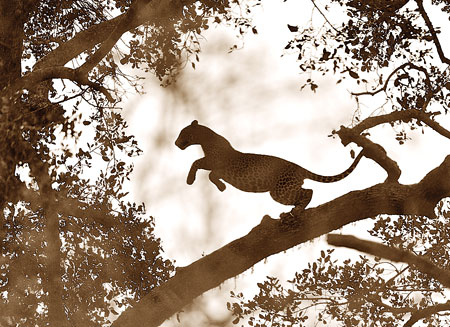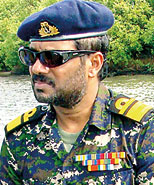It’s now or never – protect Sri Lanka’s National Parks or the consequences will be disastrous.
This is the message being given loud and clear by none other than a person whose wildlife photograph (No. 6054) has been shortlisted for the National Geographic 2011 Photo Competition.
His many forays into the country’s National Parks not only to “capture” animals in the wild but also because he is a nature lover, have however, left Dr. Lalith Ekanayake perturbed over the “indiscipline” of humans at these locations meant to be havens for wild animals. The recent accident at Yala in which a leopard cub was run over by a vehicle has unnerved him.
Although he is most lured by Yala, he has also trodden the unbeaten path and those not designated as protected areas such as the wilds of Talaimannar, Mannar and Kala wewa.
Zeroing on Yala’s Block 1 which is open to visitors, he points out that although it is relatively “small” being only 60 sq/m the density of animals is “huge”. The highest number of leopards, the predator at the top of the food chain in this country, is found at Yala, he says to prove his point.
 |
| The photograph that has been shortlisted for the National Geographic 2011 Photo Competition |
Preservation should be the core factor, stresses Dr. Ekanayake, for these “wild treasures” which have taken millions of years to evolve cannot be built by humans. If destroyed, natural wildlife would be gone forever, says this Surgeon Rear Admiral who is the Medical Director of the Sri Lanka Navy, Consultant Physician and Gastroenterologist and Consultant in Diving and Hyperbaric Medicine.
This wildlife enthusiast who held his first exhibition last year and whose book, ‘The Untamed Road’ was snapped up, all 1,200 copies in six months, says, there will be no second edition, for a new book in a different format is on the way for next year.
Rules and regulations should be brought in, he urges, having seen the deplorable discipline within the National Parks and the fact that visitor-numbers are increasing due to an end of the conflict.
Simple but essential are the suggestions he makes. “Restrict the number of vehicles entering the National Parks in a planned manner,” says Dr. Ekanayake, countering the argument that it would lead to a drop in the money flowing in, by asking what would happen if “nothing is left” due to over-exploitation. Not a cent would come in then. Not only the authorities, but even safari jeep drivers whose families live on these earnings would lose out.
The preservation and conservation of National Parks would be a long-term investment as opposed to short-term gain, he says, citing the example of parks in Africa and India which restrict the number of vehicles.
The tiger sanctuary of Ranthambore in Rajasthan, India, which has six zones allows only 35 vehicles per zone a day, he says, adding, that too only petrol vehicles, as opposed to diesel vehicles to cut down noise as well as air pollution. He paints a picture of the chaos at Yala with about 200 vehicles entering on certain days (especially in April, August and December) causing not only air and noise pollution but also disturbing the wild animals in their own habitat.
 |
| Dr. Ekanayake |
“Yala is the only National Park in the world which allows two-door big buses to drive around causing a huge adverse impact,” says Dr. Ekanayake. “This should be halted immediately and the Department of Wildlife Conservation should have a few 20-seater Canters painted green to blend with the environment taking larger groups after charging a nominal fee.
Another way to restrict vehicles is to stop issuing park entry tickets from 10 a.m. to 2 p.m. during school holidays, so that only true wildlife lovers actually enter early morning or late afternoon.”
Critical of the opening of Yala during the severe-drought period each year since 2008, he says movement of vehicles within the National Park hinders the wild animals’ access to the little water available. Once again keeping Yala open 365 days for a couple of bucks more is short-term thinking, according to him.
Stop right there and don’t expand the accommodation facilities in the form of seven bungalows and about eight campsites, he appeals, adding that the singing and rowdy enjoyment at night of those holidaying inside the park disturb the wildlife. Solid advice from a crusader for Sri Lanka’s wildlife heritage, that needs to be heeded by the authorities.
Some tips
Dealing with the deplorable state at the entrance to Yala, Dr. Ekanayake says let alone not having a “waiting” area, compelling people to stay in their vehicles, there are no proper toilets. Yala is world famous and these are basic requirements.He laments the lack of instructions on how to behave in the National Park too. Did you know that people are not supposed to smoke or drink in the park and that visitors are expected to go with a tracker?
There should be a website as well as a simple one-page leaflet giving the do’s and don’ts, he points out.
The number of guides should also be increased, as when people are allowed to go in without trackers, they get unnecessary freedom. Well-trained guides with pride in the work they do, who can also describe the animals and their habitats and are familiar with tracking leopards would be an asset, he says, also focusing on the “uniform” they should be given.
In this hot and humid weather, nylon clothes are out. They should be attired in comfortable civilian clothes, such as cotton T-shirts, he adds.
|



